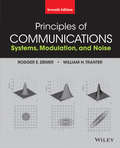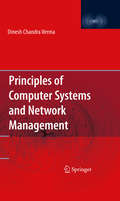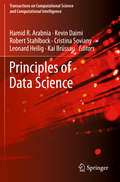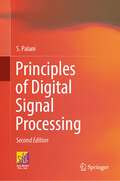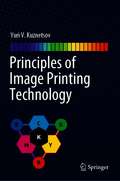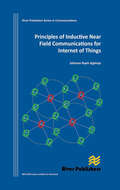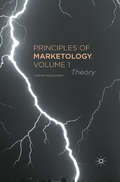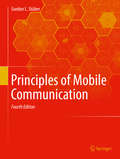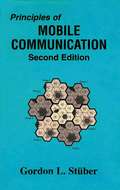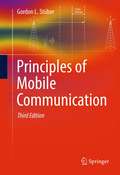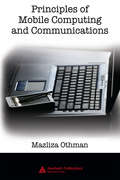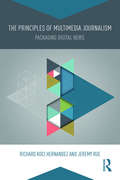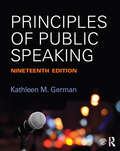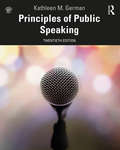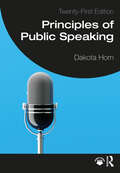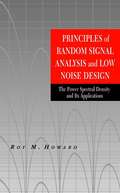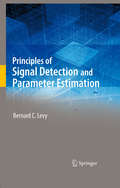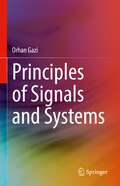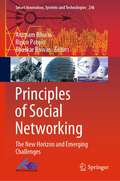- Table View
- List View
Principles of Communications
by Rodger E. Ziemer William H. TranterKeeping up to date with the most current technologies in the field is essential for all effective electrical and computer engineers. The updated 7th edition of Principles of Communications presents the reader with more in-chapter examples, providing for a more supportive framework for learning. Readers are exposed to digital data transmission techniques earlier in the book, so they can appreciate the characteristics of digital communication systems prior to learning about probability and stochastic processes. They will also find expanded forward error correction code examples, and additional MATLAB problems.
Principles of Computer Systems and Network Management
by Dinesh Chandra VermaSystems Management is emerging as the predominant area for computer science in the enterprise, with studies showing that the bulk (up to 80%) of an enterprise IT budget is spent on management/operational issues and is the largest piece of the expenditure. This textbook provides an overview of the field of computer systems and network management. Systems management courses are being taught in different graduate and undergraduate computer science programs, but there are no good books with a comprehensive overview of the subject. This text book will provide content appropriate for either an undergraduate course (junior or senior year) or a graduate course in systems management.
Principles of Data Science (Transactions on Computational Science and Computational Intelligence)
by Hamid R. Arabnia Robert Stahlbock Kevin Daimi Cristina Soviany Leonard Heilig Kai BrüssauThis book provides readers with a thorough understanding of various research areas within the field of data science. The book introduces readers to various techniques for data acquisition, extraction, and cleaning, data summarizing and modeling, data analysis and communication techniques, data science tools, deep learning, and various data science applications. Researchers can extract and conclude various future ideas and topics that could result in potential publications or thesis. Furthermore, this book contributes to Data Scientists’ preparation and to enhancing their knowledge of the field. The book provides a rich collection of manuscripts in highly regarded data science topics, edited by professors with long experience in the field of data science.Introduces various techniques, methods, and algorithms adopted by Data Science expertsProvides a detailed explanation of data science perceptions, reinforced by practical examplesPresents a road map of future trends suitable for innovative data science research and practice
Principles of Digital Signal Processing: 2nd Edition
by S. PalaniThis book provides a comprehensive introduction to all major topics in digital signal processing (DSP). The book is designed to serve as a textbook for courses offered to undergraduate students enrolled in electrical, electronics, and communication engineering disciplines. The text is augmented with many illustrative examples for easy understanding of the topics covered. Every chapter contains several numerical problems with answers followed by question-and-answer type assignments. The detailed coverage and pedagogical tools make this an ideal textbook for students and researchers enrolled in electrical engineering and related programs.
Principles of Image Printing Technology
by Yuri V. KuznetsovPrinciples of Image Printing Technology is a unique review of technology use in the printing industry since the time of the medieval engravers and busy newsroom typesetters. It provides a historical review of the advancement of technology and describes in-depth both technical fundamentals and industrial procedures. Intended primarily for students in graphic communications programs, this book includes all the necessary background for understanding printing technology. In addition, by providing findings from basic research studies and industrial processes that have been omitted elsewhere in published volumes, it offers a useful guide to researchers and professionals in the printing industry.
Principles of Inductive Near Field Communications for Internet of Things
by Johnson I. AgbinyaNear field communication devices and the emerging field of Internet of things require efficient short range communication techniques. Classical telecommunication theory however has so far focused on radiating electromagnetic signals which is more suited to terrestrial communication systems. Over the last decade however considerable research and applications of inductive methods have emerged as innovative approaches for secure short range communications by changing the paradigm of an established model of electromagnetic communications. We have witnessed the emergence of embedded inductive medical devices, magneto-inductive waveguides, inductive pots and cooking devices, magneto-inductive sensors, wireless power transfer, inductive hearing aids and the emerging inductive point-to-point communication specifically termed near-field communication (NFC) as used in mobile phones and payment cards to name a few. While there exist a large set of distributed methods and algorithms detailing the design and performances of such applications, a significant gap is observed as a lack of detailed collection of the methods in one place which could be easily understood and used quickly by someone seeking to apply the methods.In this book this missing gap is filled with the required details and the theory of near field communication systems including both the radiating and reactive (energy coupling) near-field systems in addition to the well known far field radiation techniques. The book details the fundamental expressions and design methods which facilitate the creation of near field devices and equipment including embedded biomedical implants. The book contains recent advances in inductive communications, performance, limitations and a collection of applications. It also lays a strong foundation for the application of inductive methods for creating Internet of Things systems.
Principles of Inductive Near Field Communications for Internet of Things
by Johnson I. AgbinyaNear field communication devices and the emerging field of Internet of things require efficient short range communication techniques. Classical telecommunication theory however has so far focused on radiating electromagnetic signals which is more suited to terrestrial communication systems. Over the last decade however considerable research and applications of inductive methods have emerged as innovative approaches for secure short range communications by changing the paradigm of an established model of electromagnetic communications. We have witnessed the emergence of embedded inductive medical devices, magneto-inductive waveguides, inductive pots and cooking devices, magneto-inductive sensors, wireless power transfer, inductive hearing aids and the emerging inductive point-to-point communication specifically termed near-field communication (NFC) as used in mobile phones and payment cards to name a few. While there exist a large set of distributed methods and algorithms detailing the design and performances of such applications, a significant gap is observed as a lack of detailed collection of the methods in one place which could be easily understood and used quickly by someone seeking to apply the methods.In this book this missing gap is filled with the required details and the theory of near field communication systems including both the radiating and reactive (energy coupling) near-field systems in addition to the well known far field radiation techniques. The book details the fundamental expressions and design methods which facilitate the creation of near field devices and equipment including embedded biomedical implants. The book contains recent advances in inductive communications, performance, limitations and a collection of applications. It also lays a strong foundation for the application of inductive methods for creating Internet of Things systems.
Principles of Integrated Airborne Avionics (Springer Aerospace Technology)
by Igor Victorovich Avtin Vladimir Ivanovich Baburov Boris Victorovich Ponomarenko Yuri Grigorievich ShatrakovThis book discusses the principles, approaches, concepts and development programs for integrated aircraft avionics. The functional tasks of integrated on-board radio electronic equipment (avionics) of navigation, landing, data exchange and air traffic control are formulated that meet the modern requirements of civil and military aviation, and the principles of avionics integration are proposed. The modern approaches to the joint processing of information in navigation and landing complexes are analyzed. Algorithms of multichannel information processing in integrated avionics are considered, and examples of its implementation are presented. This book is intended for scientists and professionals in the field of aviation equipment, students and graduate students of relevant specialties.
Principles of Marketology, Volume 1: Theory
by H. AghazadehIn Principles of Marketology, Volume 1: Theory , Aghazadeh explores the definition, origins and framework of a new methodology for helping organizations better understand their market and competition.
Principles of Mobile Communication
by Gordon L. StüberThis mathematically rigorous overview of physical layer wireless communications is now in a 4th, fully revised and updated edition. The new edition features new content on 4G cellular systems, 5G cellular outlook, bandpass signals and systems, and polarization, among many other topics, in addition to a new chapters on channel assignment techniques. Along with coverage of fundamentals and basic principles sufficient for novice students, the volume includes finer details that satisfy the requirements of graduate students aiming to conduct in-depth research. The book begins with a survey of the field, introducing issues relevant to wireless communications. The book moves on to cover relevant discrete subjects, from radio propagation, to error probability performance, and cellular radio resource management. An appendix provides a tutorial on probability and random processes. The content stresses core principles that are applicable to a broad range of wireless standards. New examples are provided throughout the book to better explain the more complex material to the reader. Additional problems have also been added to those already appearing at the ends of the chapters to make the book more suitable for course instruction.
Principles of Mobile Communication
by Gordon L. StüberThis authoritative treatment of the fundamentals of mobile communications stresses the "fundamentals" of wireless and mobile communications engineering important for the design of "any" wireless system. The book differs from others in the field by stressing mathematical modelling and analysis.
Principles of Mobile Communication
by Gordon L. StüberPrinciples of Mobile Communication, Third Edition, is an authoritative treatment of the fundamentals of mobile communications. This book stresses the "fundamentals" of physical-layer wireless and mobile communications engineering that are important for the design of "any" wireless system. This book differs from others in the field by stressing mathematical modeling and analysis. It includes many detailed derivations from first principles, extensive literature references, and provides a level of depth that is necessary for graduate students wishing to pursue research on this topic. The book's focus will benefit students taking formal instruction and practicing engineers who are likely to already have familiarity with the standards and are seeking to increase their knowledge of this important subject. Major changes from the second edition: 1. Updated discussion of wireless standards (Chapter 1). 2. Updated treatment of land mobile radio propagation to include space-time correlation functions, mobile-to-mobile (or vehicle-to-vehicle) channels, multiple-input multiple-output (MIMO) channels, improved simulation models for land mobile radio channels, and 3G cellular simulation models. 3. Updated treatment of modulation techniques and power spectrum to include Nyquist pulse shaping and linearized Gaussian minimum shift keying (LGMSK). 4. Updated treatment of antenna diversity techniques to include optimum combining, non-coherent square-law combining, and classical beamforming. 5. Updated treatment of error control coding to include space-time block codes, the BCJR algorithm, bit interleaved coded modulation, and space-time trellis codes. 6. Updated treatment of spread spectrum to include code division multiple access (CDMA) multi-user detection techniques. 7. A completely new chapter on multi-carrier techniques to include the performance of orthogonal frequency division multiplexing (OFDM) on intersymbol interference (ISI) channels, OFDM residual ISI cancellation, single-carrier frequency domain equalization (SC-FDE), orthogonal frequency division multiple access (OFDMA) and single-carrier frequency division multiple access (SC-FDMA). 8. Updated discussion of frequency planning to include OFDMA frequency planning. 9. Updated treatment of CDMA cellular systems to include hierarchical CDMA cellular architectures and capacity analysis. 10. Updated treatment of radio resource management to include CDMA soft handoff analysis. Includes numerous homework problems throughout.
Principles of Mobile Computing and Communications
by Mazliza OthmanMobile computing technology has come a long way in recent years-providing anytime, anywhere communication and access to information. Bringing students up to date on important technological and industry developments, Principles of Mobile Computing and Communications examines mobile networks and relevant standards, highlighting issues unique to the m
The Principles of Multimedia Journalism: Packaging Digital News
by Richard Koci Hernandez Jeremy RueIn this much-needed examination of the principles of multimedia journalism, experienced journalists Richard Koci Hernandez and Jeremy Rue systemize and categorize the characteristics of the new, often experimental story forms that appear on today's digital news platforms. By identifying a classification of digital news packages, and introducing a new vocabulary for how content is packaged and presented, the authors give students and professionals alike a way to talk about and understand the importance of story design in an era of convergence storytelling. Online, all forms of media are on the table: audio, video, images, graphics, and text are available to journalists at any type of media company as components with which to tell a story. This book provides insider instruction on how to package and interweave the different media forms together into an effective narrative structure. Featuring interviews with some of the most exceptional storytellers and innovators of our time, including web and interactive producers at the New York Times, NPR, The Marshall Project, The Guardian, National Film Board of Canada, and the Verge, this exciting and timely new book analyzes examples of innovative stories that leverage technology in unexpected ways to create entirely new experiences online that both engage and inform.
The Principles of Multimedia Journalism: Packaging Digital News
by Richard Koci Hernandez Jeremy RueIn this much-needed examination of the principles of multimedia journalism, experienced journalists Richard Koci Hernandez and Jeremy Rue systemize and categorize the characteristics of the new, often experimental story forms that appear on today's digital news platforms. By identifying a classification of digital news packages, and introducing a new vocabulary for how content is packaged and presented, the authors give students and professionals alike a way to talk about and understand the importance of story design in an era of convergence storytelling. Online, all forms of media are on the table: audio, video, images, graphics, and text are available to journalists at any type of media company as components with which to tell a story. This book provides insider instruction on how to package and interweave the different media forms together into an effective narrative structure. Featuring interviews with some of the most exceptional storytellers and innovators of our time, including web and interactive producers at the New York Times, NPR, The Marshall Project, The Guardian, National Film Board of Canada, and the Verge, this exciting and timely new book analyzes examples of innovative stories that leverage technology in unexpected ways to create entirely new experiences online that both engage and inform.
Principles of Public Speaking
by Kathleen GermanBalancing skills and theory, Principles of Public Speaking, 19th Edition, emphasizes orality, internet technology, and critical thinking as it encourages the reader to see public speaking as a way to build community in today’s diverse world. Within a framework that emphasizes speaker responsibility, listening, and cultural awareness, this classic book uses examples from college, workplace, political, and social communication to make the study of public speaking relevant, contemporary, and exciting. This edition opens with a new chapter on speaking apprehension, and offers enhanced online resources for instructors and students.
Principles of Public Speaking (Books A La Carte Plus: Myspeechlab Ser.)
by Kathleen GermanBalancing skills and theory, Principles of Public Speaking, 19th Edition, emphasizes orality, internet technology, and critical thinking as it encourages the reader to see public speaking as a way to build community in today’s diverse world. Within a framework that emphasizes speaker responsibility, listening, and cultural awareness, this classic book uses examples from college, workplace, political, and social communication to make the study of public speaking relevant, contemporary, and exciting. This edition opens with a new chapter on speaking apprehension, and offers enhanced online resources for instructors and students.
Principles of Public Speaking
by Kathleen GermanBalancing skills and theory, this introductory public speaking textbook encourages the reader to see public speaking as a way to build community in today’s diverse world. Within a framework that emphasizes speaker responsibility, listening, and cultural awareness, this classic book uses examples from college, workplace, political, and social communication to make the study of public speaking relevant, contemporary, and exciting. This new edition includes expanded coverage of mediated speaking with examples from podcasts and online speaking contexts; discussion of ethical issues of contemporary public discourse, including disinformation and public civility; and tips for extemporaneous speaking. This textbook is ideal for general courses on public speaking as well as specialized programs in business, management, political communication, and public affairs. A companion website including an instructor’s manual containing discussion questions, exercises, quiz questions, and suggestions for syllabus design is available at www.routledge.com/cw/german.
Principles of Public Speaking
by Kathleen GermanBalancing skills and theory, this introductory public speaking textbook encourages the reader to see public speaking as a way to build community in today’s diverse world. Within a framework that emphasizes speaker responsibility, listening, and cultural awareness, this classic book uses examples from college, workplace, political, and social communication to make the study of public speaking relevant, contemporary, and exciting. This new edition includes expanded coverage of mediated speaking with examples from podcasts and online speaking contexts; discussion of ethical issues of contemporary public discourse, including disinformation and public civility; and tips for extemporaneous speaking. This textbook is ideal for general courses on public speaking as well as specialized programs in business, management, political communication, and public affairs. A companion website including an instructor’s manual containing discussion questions, exercises, quiz questions, and suggestions for syllabus design is available at www.routledge.com/cw/german.
Principles of Public Speaking
by Dakota HornNow in its 21st edition, this introductory public speaking textbook encourages the reader to see public speaking as a way to build community in today’s diverse world.Within a framework that emphasizes speaker responsibility, listening, and cultural awareness, this classic book uses examples from college, the workplace, and political and social communication to make the study of public speaking relevant, contemporary, and exciting. Balancing skills and theory, new author Dakota Horn provides expanded coverage of speaking anxiety and understanding and delivering digital presentations along with two new chapters on culture and diversity and diversifying speeches. Each chapter also contains in-class applied activities to support students' learning.This textbook is ideal for general courses on public speaking as well as specialized programs in business, management, political communication, and public affairs.An Instructor’s Manual featuring discussion questions and guides, exercises, quiz questions, and suggestions and resources for syllabus design as well as PowerPoint slides is available at https://www.routledge.com/9781032537634
Principles of Public Speaking
by Dakota HornNow in its 21st edition, this introductory public speaking textbook encourages the reader to see public speaking as a way to build community in today’s diverse world.Within a framework that emphasizes speaker responsibility, listening, and cultural awareness, this classic book uses examples from college, the workplace, and political and social communication to make the study of public speaking relevant, contemporary, and exciting. Balancing skills and theory, new author Dakota Horn provides expanded coverage of speaking anxiety and understanding and delivering digital presentations along with two new chapters on culture and diversity and diversifying speeches. Each chapter also contains in-class applied activities to support students' learning.This textbook is ideal for general courses on public speaking as well as specialized programs in business, management, political communication, and public affairs.An Instructor’s Manual featuring discussion questions and guides, exercises, quiz questions, and suggestions and resources for syllabus design as well as PowerPoint slides is available at https://www.routledge.com/9781032537634
Principles of Random Signal Analysis and Low Noise Design: The Power Spectral Density and its Applications (Wiley - IEEE)
by Roy M. HowardDescribes the leading techniques for analyzing noise. Discusses methods that are applicable to periodic signals, aperiodic signals, or random processes over finite or infinite intervals. Provides readers with a useful reference when designing or modeling communications systems.
Principles of Signal Detection and Parameter Estimation
by Bernard C. LevyThis textbook provides a comprehensive and current understanding of signal detection and estimation, including problems and solutions for each chapter. Signal detection plays an important role in fields such as radar, sonar, digital communications, image processing, and failure detection. The book explores both Gaussian detection and detection of Markov chains, presenting a unified treatment of coding and modulation topics. Addresses asymptotic of tests with the theory of large deviations, and robust detection. This text is appropriate for students of Electrical Engineering in graduate courses in Signal Detection and Estimation.
Principles of Signals and Systems
by Orhan GaziThe textbook presents basic concepts of signals and systems in a clear manner, based on the author’s 15+ years of teaching the undergraduate course for engineering students. To attain full benefit from the content, readers should have a strong knowledge of calculus and be familiar with integration, differentiation, and summation operations. The book starts with an introduction to signals and systems and continues with coverage of basic signal functions and their manipulations; energy, power, convolution, and systems; Fourier analysis of continuous time signals and digital signals; Laplace transform; and Z transforms. Practical applications are included throughout. The book is also packed with solved examples, self-study exercises, and end of chapter problems.
Principles of Social Networking: The New Horizon and Emerging Challenges (Smart Innovation, Systems and Technologies #246)
by Anupam Biswas Ripon Patgiri Bhaskar BiswasThis book presents new and innovative current discoveries in social networking which contribute enough knowledge to the research community. The book includes chapters presenting research advances in social network analysis and issues emerged with diverse social media data. The book also presents applications of the theoretical algorithms and network models to analyze real-world large-scale social networks and the data emanating from them as well as characterize the topology and behavior of these networks. Furthermore, the book covers extremely debated topics, surveys, future trends, issues, and challenges.
